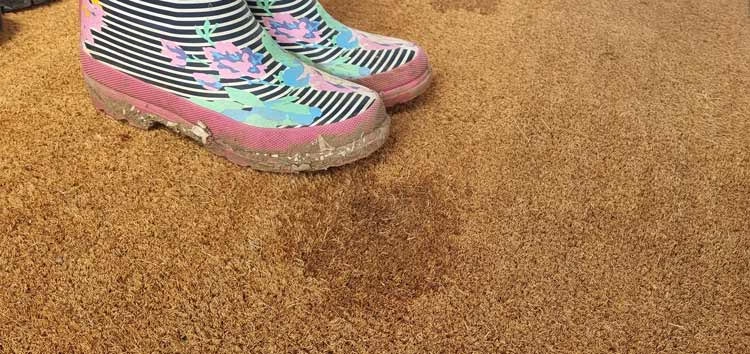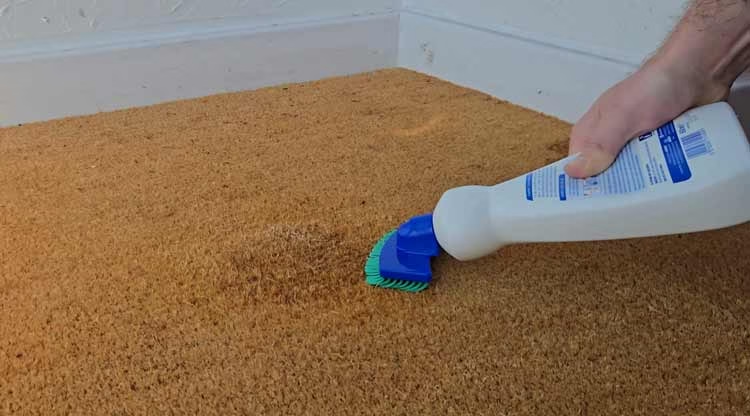![]() 0121 312 3222 (Mon-Fri)
0121 312 3222 (Mon-Fri)
Coir Matting: Cleaning & Maintenance Guide for Longevity & Performance
Coir matting, with its natural look and robust texture, has become an incredibly popular choice for both home and business entrances
This stylish, durable, and eco-friendly option offers super absorbency and can even be customised to fit specific needs. However, like all matting, but more so with coir being a natural fibre, coir requires proper cleaning and maintenance to ensure its optimal performance and to retain its inviting appearance over time.
Drawing on over 20 years of experience selling coir mats, we have compiled this comprehensive guide to walk you through everything you need to know about caring for your coir mat, from understanding its unique characteristics to effective cleaning techniques and tips for extending its lifespan.
Table of Contents

Understanding Natural Coir Mats: Key Characteristics & Considerations
Before we cover cleaning coir mats, it’s helpful to understand a few inherent characteristics of natural coir mats that set them apart from synthetic alternatives.
Initial Shedding
When you first receive your coir mat, you might notice some loose fibres shedding, particularly during initial use. This is completely normal and will subside quickly. Higher quality coir mats tend to shed less than lower quality ones. To manage this and help remove loose fibres, regular brushing with a stiff broom or light vacuuming with a roller brush or upholstery attachment is recommended.

Moisture Management & Ideal Usage
Coir excels at removing and absorbing moisture, making it an effective barrier against dirt and dampness. However, it’s best suited for use in dry conditions where it will be most effective and long-lasting. While coir fibres are water-resistant, strong, and durable, they draw moisture into the coir fibre. It’s important to avoid letting the mat become saturated in patches unless it’s being used outdoors, where the entire mat will be saturated. This can cause staining of the coir fibres. Additionally, the fibres may swell, which may cause the mat backing to become warped.
To prevent issues, avoid leaving items such as wet boots or dripping umbrellas on the mat for extended periods. If possible, position your coir mat in a sheltered location to minimise exposure to heavy rain. For areas consistently exposed to bad weather, we recommend rubber mats or specialist outdoor mats as a more suitable alternative.
How Often and How to Clean Coir Matting: Dry & Wet Methods
Coir matting is relatively low-maintenance and can be cleaned as needed. Regular attention will keep it looking fresh and vibrant.
Dry Coir Mat Cleaning (Regular Maintenance)
For routine upkeep, follow these steps:
- Shake it off! If possible, take your coir mat outside and give it a good shake to remove the vast majority of loose dust and dirt. This also provides an opportunity to clean the floor around the mat or the mat well if it’s a recessed mat.
- Vacuum Regularly: Once most of the loose dust and dirt has been shaken out, vacuum your coir mats once a week or more to suck up any excess debris.
- Use the Right Attachment: For best results, use a vacuum cleaner with a roller brush or a brush attachment to agitate the pile and remove ingrained dirt.
- Benefits: Regular vacuuming prevents dirt from embedding into the fibres, keeping the coir material fresh and vibrant.

Cleaning Wet or Heavily Soiled Coir Mats (What to do when your mat gets particularly dirty or suffers a spillage)
If your coir mat becomes particularly dirty or suffers a spillage, this presents a more complex cleaning challenge, but in many cases can still be remedied as follows.
Remove Loose Dirt: If the mat is muddy or very dirty, remove as much of the loose dirt as you can without rubbing it into the mat. If possible, hang the mat up and beat the dirt out in an outdoor space to release loose and trapped dirt. Be aware that this may release a lot of dust, hence why we suggest doing so outdoors.
Soak Up Excess Moisture: If you can act quickly enough, mop up as much of the spill as soon as possible using a cloth or a wet pick-up vacuum. Do not rub and take care not to spread the dirt further into and around the mat. Then wait for the mat to dry.
Spot Clean: For small spills or stubborn dirt patches, when dry, you can spot-clean your coir mat with a mild soap and water solution.
Lightly Dampen, Do Not Soak: Be sure not to soak the mat; lightly dampen it instead.
Stain Removal: To remove stubborn stains, brush or use a sponge with a small amount of carpet shampoo dissolved in warm water. Avoid saturating the fabric and allow to dry fully between cleans. Repeat the process as many times as required to remove the stain. A rough brush is best suited to cleaning stains from the tough, bristly fibres of coir mats.
Dry Naturally: After cleaning, leave the mat out to dry naturally, preferably outside in sunshine and a breeze. Do not fold coir mats, as this can damage the mat.

What to Avoid When Cleaning Coir Matting
When maintaining your coir mats, there are certain things you should avoid to prevent damage and preserve their natural integrity.
- Harsh Chemicals or Detergents: Do not use harsh chemicals or detergents when cleaning coir mats. These substances can harm the natural fibres of the coir, reducing its durability and lifespan.
- Soaking in Water: Avoid soaking the mats in water. This can damage the fibres and damage the fibres and warp the mat as well as making them susceptible to mould and mildew growth.
- Machine Washing: Using a washing machine to clean a coir doormat is not advisable, as it will damage the mat and likely the washing machine too.
- Steam Cleaning: Steam cleaning a coir doormat is also not something you should try, as it will damage the coir mat.
For areas where moisture is a constant concern or where frequent washing is desired, consider our range of Washable Mats, which are made from materials more resistant to moisture and have the advantage of being machine washable
How to Prevent Coir Matting from Fading
One common concern among homeowners is that their beautiful entrance mats may fade over time due to exposure to sunlight. To prevent this and keep your mat looking vibrant:
- Shady Spot: Place your coir mat in a shady spot if possible.
- Colour Choice: Avoid colours such as reds and blues, which are particularly susceptible to fading.
- UV Protectant Spray: Apply a UV protectant spray, which helps guard against harmful sun rays causing discolouration.

Maximising the Lifespan of Your Coir Matting
Proper care and maintenance not only keep your coir mat looking its best but also significantly extend its lifespan.
- Rotate Regularly: If possible, regularly rotate your coir mat to ensure even wear. This simple step can prevent premature thinning in high-traffic areas.
- Use a Mat Well or Recess: Consider using a mat well or recess for your coir mat. This provides added protection, helps maintain the shape and integrity of the mat over time, and can also help trap any shedding bristles, making them easier to vacuum.
- Opt for Made-to-Measure: Our range of made-to-measure mats are cut precisely to fit your space. This reduces the risk of edges fraying or becoming worn due to improper sizing.
- Edging Strips: If you have to loose lay your mat, consider using edging strips to protect the edges from fraying.
- Regular Vacuuming: A regular vacuuming of your coir mat will increase its lifespan and eradicate any shedding issues.

Conclusion: Preserve the Rustic Charm of Your Coir Mat
Proper coir matting maintenance is key to ensuring that your stylish home entrance remains attractive and welcoming. By following these comprehensive care instructions, you can extend the lifespan of your coir matting and enjoy its rustic charm for many years to come.
Ready to explore more? Check out our extensive collection of premium quality coir mats today!
Further Resources for Coir Matting Excellence
- For more tips on cutting and installing coir matting, don’t forget to visit our guide on “How To Cut And Install Coir Matting“.
- Fed up of cleaning and replacing your coir matting? Synthetic Coir Matting may be a better choice. Find out the differences between natural coir and synthetic coir here: “Natural Coir vs Synthetic Coir“.
